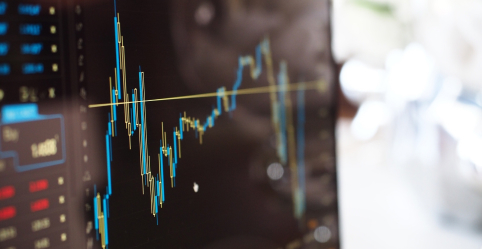Why we feel panic when markets are volatile
How to stay calm when markets are volatile

COVID-19 has impacted every one of us and created an unprecedented sense of global uncertainty. Many businesses are on hold, citizens are being asked to distance themselves from others and global markets have entered a period of volatility. This sense of uncertainty has many wondering what they should do next with their portfolios.
For many investors, this may be the first market downturn they’ve had to navigate. And, while the uncertainty may seem scary, there are lessons we can learn from previous volatile markets to help us steer our investments in the right direction. For that, we don’t have to look too far to the past.
A lesson from the past
It’s only been a decade since the 2008 financial crisis, but for Lisa Kramer, a finance professor at the Rotman School of Management, one thing still stands out - investors selling their stocks in droves. Many of those panicked investors were soon-to-be-retirees who saw their savings slashed in half. Rather than waiting for the market to rebound, they sold as much as they could.
“People just wanted to preserve what was left,” says Kramer. “Had they just looked away from their statements or computer, they could have just ridden out that downturn and their portfolios would have recovered.”
It’s understandable that people might have felt panicked, especially in 2008, but they get nervous even when the market falls by a few percentage points. And panic selling goes against everything investors have been taught. Advisers and fund managers always say investing should be a long-term game.
Why do people panic then? “Blame it on our brains”, says Kramer. We feel losses more than gains, we tend to follow the crowd and it’s just hard to stay calm when negative headlines are dominating our news feeds.
Fortunately, there are strategies we can use to help us stay calm when the market falls.
Why do we panic?
First, it’s important to know why we get so nervous. It has to do with our innate feelings of fear and greed. When markets rise, people get excited about the prospect of making money and they get jealous of other people who have made a buck, says Kramer. This may cause them to invest in riskier investments and take chances they normally wouldn’t.
However, as greedy as we get on the upside, we feel far more panicked on the downside. Why? Because of something called prospect theory, which has found that people feel the pain of losses much more intensely than the pleasure of gains.
Prospect theory, which was first proposed by psychologists Daniel Kahneman and Amos Tversky in 1979, says that investors value losses and gains differently and they make financial decisions based on those different value sets. In their landmark paper they wrote, “The aggravation that one experiences in losing a sum of money appears to be greater than the pleasure associated with gaining the same amount.”

Others have corroborated their research. In a 2014 study in the journal Decision, researchers discovered that losses led to feelings ratings that were more extreme than those indicated for equivalent gains.
“When our portfolios go down a lot, it’s just so painful to us,” says Kramer. “What comes after that isn’t in our best interest financially,” as investors tend to liquidate their assets that have gone down in value, she explains.
So, what can you do to lessen those worried feelings? Here are a few suggestions.
Review your risk
The first place to start is with your plan. Do a review to make sure your risk tolerance level is accurate. Advisers can help with this process, but if you’re a DIY investor, you’ll need to ask yourself, over and over again, if you can stomach big losses and if you have the right portfolio mix. If you get queasy when the market falls, then that could be a sign that your asset mix needs to change, says Kramer Be careful to keep emotions out of any decision you make.
To know what that mix should be, run through a variety of market scenarios, on your own or with an adviser, to learn what could happen to your investments, recommends Kramer. See how much you might lose in a 10% correction, a 20% bear market and a bigger crash.
You can’t just have an abstract chat about possible losses either. It helps to translate it into a dollar amount. Research has found that people react more strongly if they’re told they can lose $20,000 of their $200,000 portfolio than if you tell them they may lose 10% of their investment. “It’s converting risk into terms they can understand,” she explains.
Protect yourself
Stop loss orders can be helpful in protecting against losses, too. This is when an investor puts a sell price on a stock. If the company’s share price hits that level then the broker will automatically sell out of all or part of the investor’s position. Having that protection may help you feel better at night. However, Ben Felix, a professional money manager and author of Common Sense Investing blog, says that “it only solves one side of the problem. The hard part is knowing when to get back in.”
Check returns less frequently
It can also help to limit how much time you spend checking your statements and performance online. “You’re going to see bigger numbers and smaller numbers,” says Kramer. She suggests reviewing your performance from time to time, as well as annually. If you have questions you can’t answer, then consider meeting with a financial adviser who can help determine if you’re on the right financial track.
Don’t believe everything you read
While it’s a good idea to stay on top of financial markets by watching television news and following the right social media accounts, watching too much can lead to a fear of missing out and to making rash investment decisions, on both the buying and selling side. “They’ve probably faced the same challenges you’ve faced,” cautions Kramer, of these pundits.
Overall, the aim is to build resilience when it comes to your portfolio. Kramer says to ask yourself, “Are you the kind of person who can look away when bad things happen?” The answer should be yes.
The market experiences ups and downs; periods of gains and periods of losses. Right now, we’re in the midst of a down market, which can be a confusing time for investors. But, as history has shown, re-visiting your risk tolerance and sticking with your investment strategy proves to be the best way forward during periods of market volatility.
Ready to start investing?
Start investing online with BMO InvestorLine Self-Directed.
Related articles
Have questions?
Quotes in this article have been obtained through phone interviews.
The information contained herein is not, and should not be construed as, investment, tax or legal advice to any party. Investments should be evaluated relative to the individual’s investment objectives and professional advice should be obtained with respect to any circumstance.

